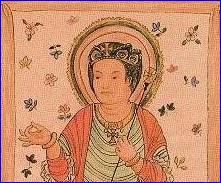Assyrian Christian Influences on Early Japanese Buddhism

A restoration of the original silk painting of a missionary bishop of the Church of the East, now in the British Museum, London, discovered by Sir Aurel Stein at Tun-huang, western China, in 1908. It had been found, along with many manuscripts including some Christian ones, in a cave sealed in 1036. This restoration was painted by Robert MacGregor.
I stumbled on this while researching for this coming Sunday’s sermon on the so-called Jesus Sutras, early Chinese Nestorian Christian texts.
Turns out that in 782 an Indian Buddhist monk named Prajna came to the Chinese imperial capital Chang’an. He carried with him a collection of Sanskrit Buddhist texts. He found an unlikely collaborator in doing his translations in the person of a Nestorian bishop, Adam. The two embarked on a twenty year long project. The results of their efforts was a seven volume collection of the Buddhas’ teachings.
Near the end of their project Saicho and Kukai, two Japanese Buddhist monks arrived in quest of Buddhist texts. And they returned to Japan with the seven volume anthology. Kukai would become the founder of the Shingon school while Saicho would establish the Tendai school, from which both the Japanese Shin or Pure Land and the Zen schools would emerge.
Several scholars have speculated on the degree to which Bishop Adam’s syncretic Nestorian Christianity seeped into those Chinese texts, and from there to consider to what degree Christian spirituality, if an eccentric version, could have influenced the formation of four different schools of Japanese Buddhism.
Editor’s note: see the following books on the Assyrian Church of the East missionary activity in Mongolia, China, Korea, Japan and the Phillipines:
- By Foot To China: Mission of The Church of the East, to 1400
- The Monks of Kublai Khan
- History of Christianity in Asia: Volume One, Beginnings to 1500; Samuel Moffet; Harper Collins; 1994.
© Assyrian International News Agency.
